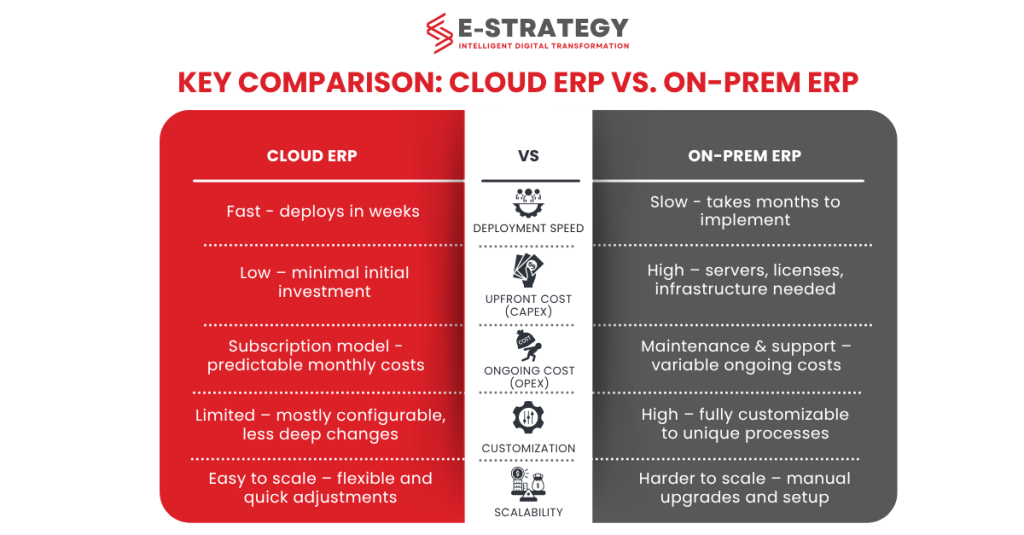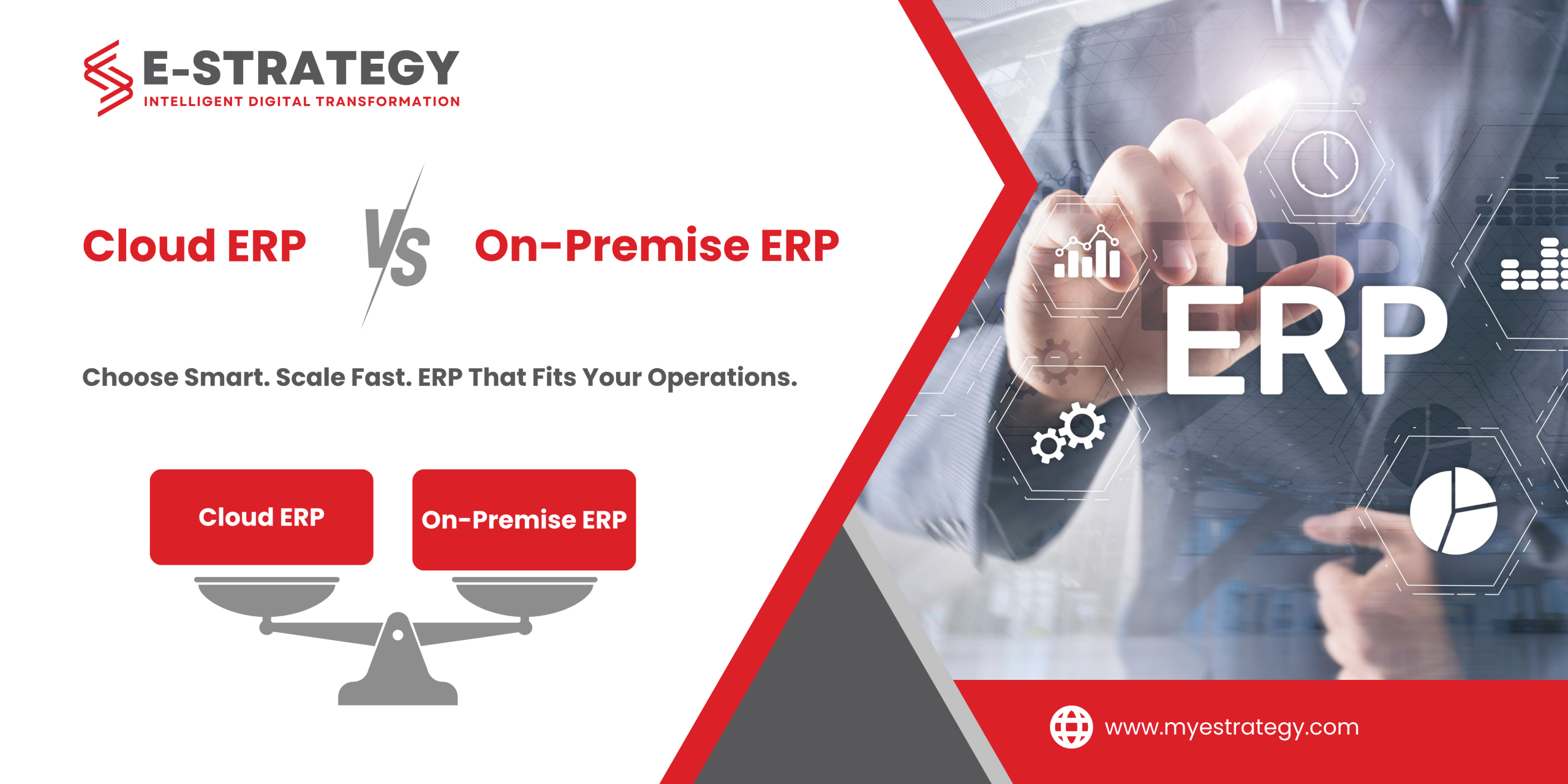In today’s fast-paced manufacturing landscape, choosing the right ERP system isn’t just an IT decision -it’s a strategic one.
You’ve likely heard the terms “Cloud ERP” and “On-Premise ERP” thrown around a lot. But which one is better suited for your business? More importantly, which one aligns with your growth strategy, budget, and operations?
This blog breaks down the key differences, pros, cons, and use cases – with U.S. manufacturers and North American businesses in mind.
Cloud ERP vs. On-Premise ERP: Key Differences for 2025

Cloud ERP Explained: Features and Examples
Cloud ERP is a type of enterprise resource planning software hosted on the vendor’s servers and accessed via a web browser. It’s delivered as Software as a Service (SaaS), where updates, data storage, and maintenance are managed off-site.
Example: SAP S/4HANA Cloud, GROW with SAP
On-Premise ERP Explained: Features and Examples
On-premise ERP systems are installed locally on your company’s servers and managed by your internal IT team. You’re responsible for software updates, security, infrastructure, and maintenance.
Example: SAP S/4HANA On-Premise
How to Select the Right ERP Solution for Your Industry
Let’s break it down across the factors that matter most to manufacturers.
1. Deployment Speed and Cost
Cloud ERP
- Fast implementation: Go live in weeks, not months
- Lower upfront costs: Subscription-based (OpEx model)
- Minimal IT support needed
Ideal for small to mid-size manufacturers or those expanding quickly.
On-Premise ERP
- Longer deployment cycle: Often 6–12 months
- High upfront investment: Includes hardware, licenses, setup (CapEx model)
- In-house IT required for support and maintenance
More suitable for large enterprises with existing infrastructure.
2. Scalability and Flexibility
Cloud ERP
- Highly scalable – Add users or features easily
- Ideal for multi-location, remote teams
- Supports mobile and browser access natively
Cloud ERP is purpose-built for flexibility. U.S.-based manufacturing companies expanding to Canada or Mexico benefit from real-time, global access.
On-Premise ERP
- Limited scalability without significant upgrades
- Less mobile-friendly unless customized
- Remote access requires VPNs and complex security layers
3. Customization and Control
On-Premise ERP
- Full control over data and infrastructure
- Highly customizable for complex workflows
- Ideal for manufacturers with unique regulatory or operational needs
Some industries (e.g., aerospace, defense) require on-prem due to data sovereignty and compliance laws.
Cloud ERP
- Limited customization out-of-the-box
- Frequent updates may restrict certain modifications
- Better suited for businesses that can adopt best practices vs. highly customized flows
4. Security and Compliance
Cloud ERP
- Leading vendors like SAP invest heavily in cybersecurity, encryption, and data redundancy
- Regular compliance audits (e.g., SOC 2, ISO, GDPR, HIPAA)
- 24/7 monitoring and automated patches
This is especially beneficial for U.S. manufacturers aiming for cybersecurity maturity models (CMMC) or ISO certifications.
On-Premise ERP
- Security is your responsibility
- Requires a skilled IT team to manage firewalls, patches, and audits
- May be preferred for strict internal data governance
5. Maintenance & Updates
Cloud ERP
- Updates happen automatically
- Zero downtime in most cases
- No additional cost or staff involvement
On-Premise ERP
- Manual updates, often done annually or quarterly
- Can lead to delays and version-lock issues
- Extra cost and resources needed for each upgrade
6. Long-Term ROI and Total Cost of Ownership (TCO)
Cloud ERP
- Lower TCO over 3–5 years
- Subscription includes hosting, support, and security
- Pay-as-you-grow model
Cloud ERP solutions are often more cost-effective for SMB manufacturers and companies in growth mode.
On-Premise ERP
- Higher TCO due to hardware, maintenance, and staffing
- Long-term ownership may be cheaper only for stable, legacy businesses with little change
Cloud ERP is Winning in North America – Here’s Why
Across the U.S. and Canada, cloud-based ERP systems are rapidly becoming the standard in manufacturing.
Why?
- The “as-a-service” model aligns with lean, agile business models
- Cloud ERP providers now offer industry-specific solutions (like SAP’s GROW with SAP for manufacturers)
- More companies are moving toward hybrid work and multi-location operations
For example, a mid-size automotive supplier in Michigan expanding to Tennessee and Mexico can use Cloud ERP to unify operations without building new server infrastructure in each site.
When is On-Premise ERP Still the Right Choice?
Despite the momentum, on-premise ERP is not obsolete.
Choose On-Prem ERP if:
- You require total control over your infrastructure
- You have unique business models or complex customization needs
- You must comply with strict data residency laws
- Your IT team is experienced and well-resourced
- You’ve already invested heavily in on-premise infrastructure
Hybrid ERP: The Best of Both Worlds?
Many large U.S. manufacturers are now adopting hybrid ERP models – a mix of cloud and on-premise tools. This allows:
- Core operations to stay on-premise
- Non-critical modules like HR, CRM, or analytics to be moved to the cloud
- Smooth transition and scalability over time
SAP offers tools to support such hybrid strategies, allowing modular migration toward the cloud without losing legacy investments.
Choosing the Right ERP for Your Business
There’s no universal answer – but there’s definitely a right fit for your business stage, budget, and goals.
Here’s a quick reference:
| Need | Best Fit |
| Fast deployment & scalability | Cloud ERP |
| Full control over customization | On-Premise ERP |
| Lean IT team or limited resources | Cloud ERP |
| High security and compliance requirements | Depends on internal capabilities |
| Expansion to multiple locations | Cloud ERP |
| Legacy systems with deep integrations | On-Prem or Hybrid |
Final Thoughts: It’s Not Cloud vs. On-Prem – It’s Cloud for the Future
U.S. and North American manufacturers face rising costs, tighter margins, and rapid digital disruption.
Cloud ERP helps you move faster, scale easier, and compete smarter.
But the right decision depends on where your company is today – and where you want to be tomorrow.
Ready to Modernize Your Manufacturing ERP?
Book a complimentary, no-obligation ERP Readiness Assessment with our certified SAP experts. You’ll receive:
- A personalized cloud vs. on-premise roadmap
- ROI and cost-benefit analysis tailored to your operations
- Practical next steps for your 2025 digital transformation
Limited free assessments available-contact us at sales@myestrategy.com or click below to claim yours.

Certified SAP Partner | Cloud ERP Experts | Manufacturing-Focused

